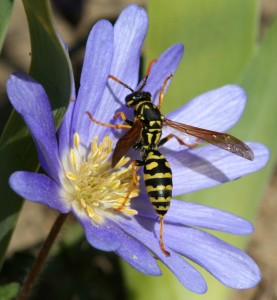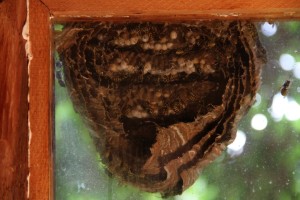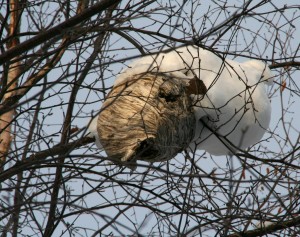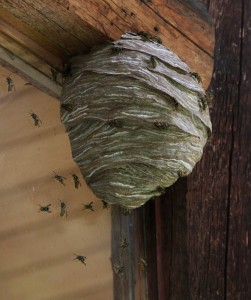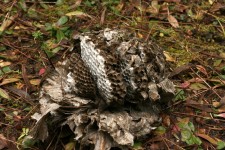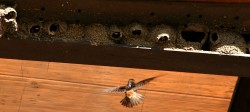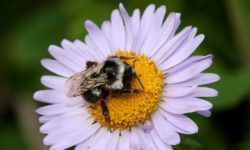Warmer, drier weather this spring not only helped gardeners and farmers but also stinging insects. Cold, rainy weather in April and May can reduce nest success because queens have a harder time building a nest and collecting enough food for their offspring. Wasps, yellow jackets and bald-faced hornets are plentiful this year in part to the nice spring weather.
Bees and wasps are both stinging insects but they are different. The body of a bee is partly covered in fine hairs, such as a bumblebee. The body of a wasp is bare and shiny.
Bald-faced hornets, yellow jackets and paper wasps are all species of wasps. Bald-faced hornets are a species of yellow jackets which are a type of wasp.
Each wasp has distinct characteristics that help differentiate it from other wasps. All wasps are more slender than bees.
Yellow jackets are black with irregular, jagged yellow bands while bald-faced hornets are black with a pale yellow face and a few whitish markings on the abdomen. Paper wasps resemble yellow jackets in color but are slimmer and have longer legs that hang down during flight.
Another difference is their nests. Bald-faced hornets build large football-shaped nests in trees with a single opening on the bottom. Yellow jackets typically build the same type of nest as the bald-faced hornet but it is underground in animal burrows, stumps or any cavity. However, the aerial yellow jacket builds a nest above ground like the bald-faced hornets but is more likely to build it on roof overhangs or protected building surfaces. Aerial yellow jackets don’t add leaves and twigs to the outer nest walls like bald-faced hornets.
Paper wasps build umbrella-shaped nests with the comb visible from the bottom. The nests are smaller than other wasps and are built in protected places, such as light fixtures, eaves, utility boxes and patio furniture.
While yellow jackets are the most blamed for stinging, paper wasps are actually the most common stinging pest in Idaho because their nest sites are closer to human activity. Paper wasps are relatively docile compared to yellow jackets when their nest is disturbed but they will sting sting to defend their nest. Only female wasps sting because the stinger is an egg-laying tube modified to inject venom.
In late summer and fall, wasps (especially yellow jackets) tend to be more easily provoked because natural foods are scarce and they are raising the new queens in their nests. Only the queens overwinter to begin new nests in the spring.
Food sources vary throughout the season but wasps are highly beneficial to the ecosystem. Bald-faced hornets feed almost entirely on living insects including yellow jackets. Paper wasps prey on caterpillars, soft-bodied leaf-feeding insects and nectar.
Yellow jackets primarily feed their offspring insects, such as caterpillars, beetle grubs, grasshoppers, flies and spiders. Adult yellow jackets ingest some of the prey’s bodily fluid but feed mainly on nectar. They do not produce honey like bees. As insects become scarce, yellow jackets feed on dead protein and sugary food and, thus, become a picnic pest.
With a primary food source of insects, bald-faced hornets and paper wasps tend to be less of a picnic pest.
The threats of stinging, whether at picnics or while mowing the yard, will be present until cold weather kills all but the queens.

